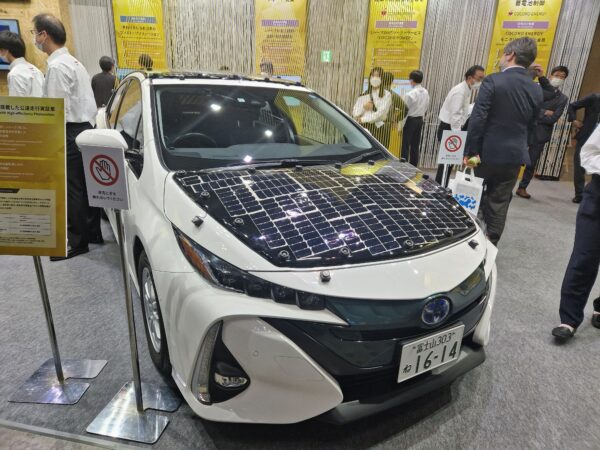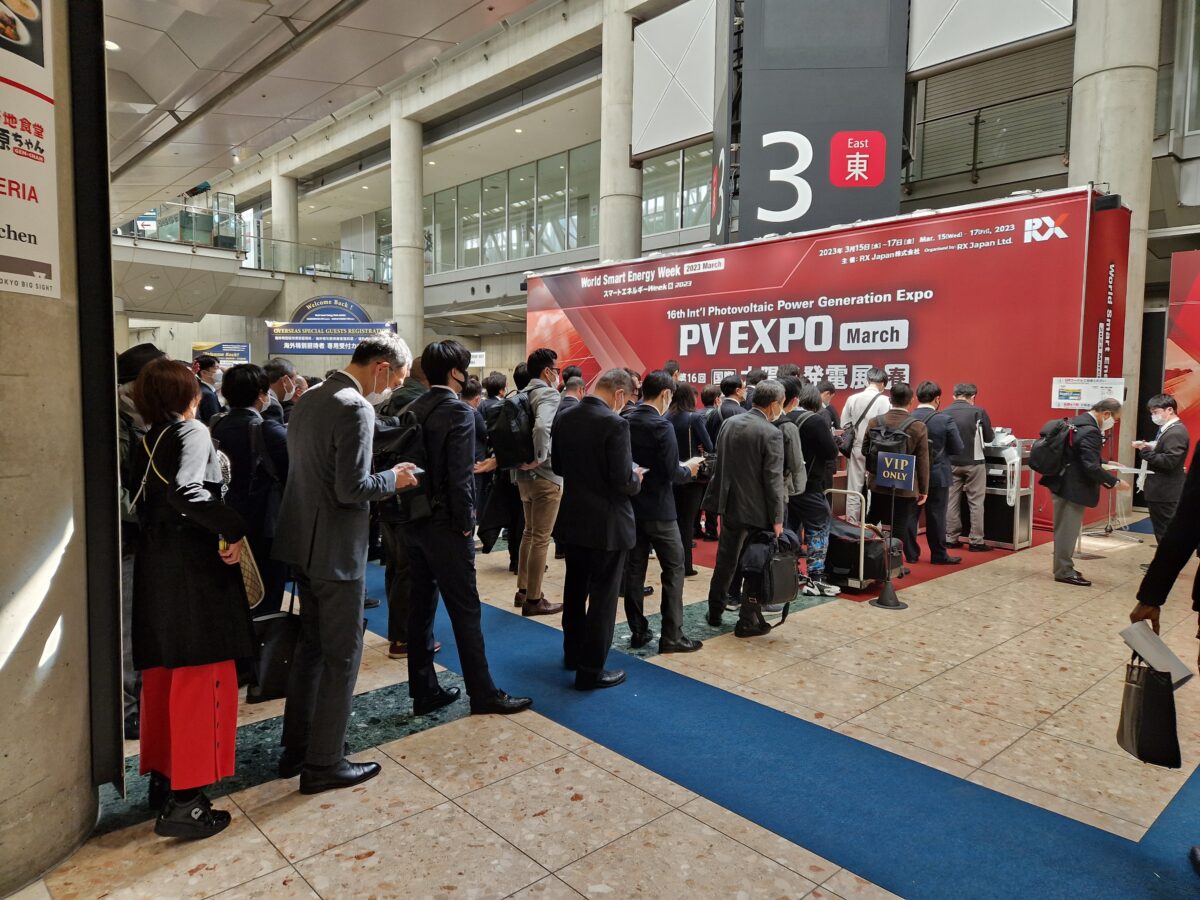Spread across three days, Japan’s Smart Energy Week again brought several thousand visitors to Tokyo Big Sight. Domestic companies were a relatively rare sight on the show floor, particularly in the PV Expo hall. But large crowds and a wealth of new innovations on display throughout the PV, battery, smart grid, and hydrogen exhibitions gave plenty to be optimistic about.
Solar and renewable energy in Japan have often been described as “in a transition period” for the past few years. Solar installations have remained at a steady 5 GW to 6 GW per year, while dwindling feed-in tariff rates and a shortage of suitable land for new large-scale PV installations have led many to ask what’s next for Japan.
The country is working towards a target of at least 36% to 38% renewables in its energy mix by 2030. An opening day presentation by Kazuya Inoue, director of climate change policy at Japan’s Ministry of Energy (MoE), noted that this would require at least a doubling of Japan’s cumulative solar capacity, and a significant uptick in installations during the second half of this decade. Inoue stated that the MoE is “committed to solar,” and its calculations show that renewable energy sources could meet at least 1.8 times Japan’s total electricity demand – meaning much is still not being exploited. And in response to this, MoE will make JPY 20 trillion ($151 billion) of funding available for various renewable energy, energy storage, and decarbonization projects up to 2030.
With little suitable land left for large-scale PV, Japan’s PV policy is switching focus to rooftop and commercial PV models. Many companies in Japan have set decarbonization targets for themselves and are looking to clean up their energy supply through solar PPAs. Tokyo based analysts RTS Corp. explained that high energy prices along with subsidies available for solar PPA installations make this a particularly attractive model at the moment.
RTS also said it expects to see Japan’s market for ground-mount solar installations shrink as residential PV grows. It noted that experimental schemes requiring solar on all new buildings are being tried out in the Tokyo and Kawasaki regions, and will likely be rolled out further in the near future.
Japan has also seen a few early installations combining solar and farmland, but opinions are divided as to whether this agrivoltaics approach will work as a solution to shortages of land for solar projects. According to RTS, agrivoltaics in Japan will likely see some growth in the years leading to 2030, but some local agricultural committees are not well prepared, and widespread reform of land-use regulations will be needed for a real market to develop.
No more PERC?
China’s cell and module producers dominated much of the PV Expo hall, and were keen to demonstrate their latest products in a market traditionally keen on the latest technologies. Every one of these companies said plans are already well underway to stop producing PERC cells completely by the end of 2024, or even sooner.
And all of the replacements were on display this week, most are taking the simplest route of upgrading to TOPCon to reach higher efficiencies. Trina Solar and JinkoSolar were among companies confirming plans to stop producing PERC entirely. And DAS Solar, which operates 30 GW of TOPCon cell capacity and plans to expand to 40 GW this years, told pv magazine this “is only beginning for TOPCon,” with expectations to reach 26% production cell efficiency in 2024.
Others, however, are looking further into the future and at even higher performance levels that could be achieved with heterojunction and back contact technologies. Manufacturers Huasun and Risen demonstrated their latest heterojunction products, with the former aiming at average production cell efficiencies better than 25% and planning to expand its capacity to 40 GW by 2025.
Longi Solar also had it latest hybrid passivated back contact products on show, and Aiko Solar showed off its latest All-Back-Contact, which its rolling out products for the rooftop market this year and expects to be able to reduce costs sufficiently for the large-scale segment over the next few years, as well as achieving better than 27% module efficiency.
Electronics giant Sharp – seemingly the only Japanese company exhibiting any type of PV module at this year’s show – demonstrated its multi-junction gallium-arsenide based cell, which hits more than 30% efficiency. Currently at more than 100 times the cost of a typical silicon cell, there’s a long way to go before this will be attractive for powering anything other than space travel. Nonetheless, the company exhibited a Toyota car covered with these cells, adding up to an impressive 860 W of solar on the vehicle body, which the company says can power a journey of up to 50 km with no other charging.
Sharp also says it is working with the New Energy and Industrial Technology Development Organization (NEDO) to bring the cost of these cells down to earth. They are developing a reusable substrate and larger-scale processes to cut more than one-third off the total costs, but don’t expect to see them on a rooftop anytime soon.

Image: pv magazine/Mark Hutchins
Japan, like many other markets with a growing share of renewable energy, has realized that it will need to do major work on its electricity networks in order to deliver all this clean energy when and where it’s needed. And the Smart-Grid expo was one place where well-known Japanese brands were more able to shine. Mitsubishi Electric had a range of software on show, demsonstrating that it is able to manage large electricity networks by combining data from multiple small installations into a virtual power plant.
Sharp, as well as Chinese companies Growatt and Sungrow, also exhibited electric vehicle chargers and previewed vehicle-to- grid and vehicle-to-home approaches, where the car’s battery while plugged in is used to maximize consumption of solar electricity from a rooftop installation, or many are linked together to scale this up to a whole region. This is an approach these companies expect to gain a lot of traction in Japan over the coming years, on the residential side, in particular.
This content is protected by copyright and may not be reused. If you want to cooperate with us and would like to reuse some of our content, please contact: editors@pv-magazine.com.




By submitting this form you agree to pv magazine using your data for the purposes of publishing your comment.
Your personal data will only be disclosed or otherwise transmitted to third parties for the purposes of spam filtering or if this is necessary for technical maintenance of the website. Any other transfer to third parties will not take place unless this is justified on the basis of applicable data protection regulations or if pv magazine is legally obliged to do so.
You may revoke this consent at any time with effect for the future, in which case your personal data will be deleted immediately. Otherwise, your data will be deleted if pv magazine has processed your request or the purpose of data storage is fulfilled.
Further information on data privacy can be found in our Data Protection Policy.